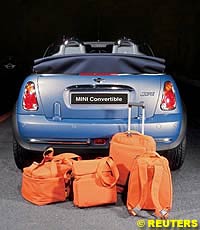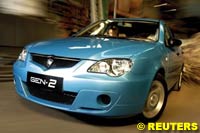

Automotive News and Reviews for the Petrolhead
In this week's issue:
- Car Briefs
- Ford Eyes Production Cuts at Jaguar
- 4x4s Destroying the Sahara
"So what?" you might say - lots of car companies make accessories. Yes, but they don't sell then like Mini does. On average, each Mini leaves the showroom with over £2000 of accessories. Essentially, the accessories make up for the profits lost by selling the basic car at such a low price.
Meanwhile, the image of the Mini means almost all customers want to personalise their cars, even though they tend to be "personalised" in exactly the same way. In fact, you see far more Minis with bonnet stripes and alloy wheels than you do in standard plain colours and steel wheels. If you are tempted, the cost for the luggage set is £354 and the sunglasses range starts at £64.95.
Proton has been having an appalling time of late: it tried to move away from its successful early positioning as "Japanese technology at Skoda prices", but customers in the few markets that received Protons couldn't see the point once prices went to the same level as actual Japanese cars. The Gen-2 is meant to establish Proton as a credible international competitor.
It may also form the basis of a new MG Rover model: the two companies are in talks about new model development. If MG Rover does spin a model of the Gen 2, Proton/Lotus will be the fourth manufacturer whose platforms they have used in the last 10 years; the three others being Honda for the 25/45, BMW for the 75 and Tata for the CityRover. Not what a marketing textbook would describe as "consistent brand values".
Citroen's pitch for the C2 VTS is just the same as for the previous model: maximum thrills for minimum cash. The price is £11,995 with an incentive of one year's free insurance for buyers aged 21 to 80 (mainland Britain only). Power from the 1.6 litre engine is 125 bhp, providing a 0-62mph time of 8.3 seconds and a maximum speed of 126mph.
Equipment includes air conditioning, power assisted steering, electric windows, alarm and a CD player, while the look of the car is enhanced by 16" alloy wheels, front foglights, chrome tailpipe, rear spoiler, aluminium gear knob and aluminium drilled pedals.
Ford is considering cutting production at its troubled Jaguar division to bring it more in line with flagging demand, a senior company official says.
Ford President Nick Scheele said last week no "firm decision" had been made about slashing output of the British-built vehicles, which are part of Ford's stable of luxury brands known as the Premier Automotive Group.
"Certainly for the number of cars sold, we have too much capacity," Scheele told Reuters, referring to Jaguar's three assembly plants.
He spoke on a visit to Chicago, where Ford was promoting its new vehicle lineup, including a family sedan and replacement for the company's aging Taurus dubbed the Five Hundred. Jaguar's US sales plunged nearly 25 percent in July and are down about 7 percent so far this year.
Its disappointing performance is weighing heavily on overall results at Premier Automotive - which is comprised of Land Rover and Volvo as well - and Ford Chief Financial Officer Don Leclair told a conference call last month that the parent company was working to turn Jaguar around.
Scheele did not elaborate on any measures beyond a production cut to address the problems at Jaguar. But he indicated that a broad restructuring may be needed to get it back to sustained profitability.
"You have to look at fixed costs," he said.
Scheele, a native of Essex, England, takes much personal interest in the fate of Jaguar. He was knighted by the Queen for helping to restore the company to automotive prominence while serving as chairman and chief executive of the Ford unit throughout most of the 1990s. Ford's luxury car business is key to its goal of booking $7 billion (4 billion pounds) in annual pretax profits by 2006.
Premier Automotive and Ford's Lincoln brand are supposed to account for a third of that profit. But Premier Automotive swung to a pretax loss of $362 million in the second quarter, compared with a profit of $166 million a year earlier.
Dust clouds from the Sahara Desert have grown tenfold over the last half century and threaten the global climate - but don't blame the camels.
"Toyota-isation", or the increasing numbers of four-wheel drive vehicles speeding over the sand, has become a major factor exacerbating the problem, a British expert said last Friday.
"It's the Toyota or Mitsubishi or whatever it may be that's replaced the camel for many people there. And they charge around disturbing the surface," Oxford University geography professor Andrew Goudie told Reuters. "Then you've got all these tourists and people who charge around, and people who just love driving in deserts, all these SUVs and so on."
Goudie, who has been investigating dust and deserts since the mid-1970s, said the problem began with the expansion of four-by-four traffic in the desert after World War Two. But it has worsened of late as wealth and car ownership have spread.
"People in areas like the Middle East were quite poor until the oil boom for example," said Goudie, who gave his findings at the International Geographical Congress in Scotland this week.
Increased drought due to climate changes, over-grazing and ploughing have also played their part in increasing the amount of dust coming out of some parts of the Sahara by nearly 10 times since the late 1940s, the academic said. The Sahel zone south of the Sahara also has acute problems.
Globalisation Of Dust
Goudie called for strict measures like bans on vehicles in sensitive areas, wires across the desert to block four-by-fours but not animals, and plenty of warning signs.
"This is being done quite successfully in parts of Namibia," he said of the signs.
Vehicles, he explained, break the crust of the desert which would otherwise be relatively stable due to algae, lichens, clay or pebbles on the surface
"When you start driving over these surfaces, you break that surface crust and then the fine dusty material underneath can be driven out into the atmosphere in dust storms."
Latest estimates of global dust emissions are about two to three billion tonnes each year, with particles from Africa travelling as far as Greenland and the Caribbean, he said. This poses a threat to human health, exacerbates global climate changes and can have a detrimental effect on other habitats including even corral reefs.
"The cross-boundary nature of dust makes it a truly global issue and one that is not receiving the attention it deserves. The importance of dust basins as a source of global dust is now being more widely understood and the magnitude of the environmental consequences identified," he said.
Britain, for example, has seen an increase in "blood rain", so-called because of its dusty, reddish colour, Goudie said. While the problem is worsening in Africa - where the Bodele depression in Chad is the world's worst dust spot - other well-known arid regions such as North America, Mexico, China and Australia are producing less, the academic said.
![]() Car Briefs
Car Briefs
 Further underlining the power of the new Mini brand, Mini and Mandarina Duck have jointly announced a new line of luggage designed just for the Mini convertible - and Mini also has a new line of designer sunglasses to tie in with the launch of the convertible.
Further underlining the power of the new Mini brand, Mini and Mandarina Duck have jointly announced a new line of luggage designed just for the Mini convertible - and Mini also has a new line of designer sunglasses to tie in with the launch of the convertible.
 Proton, the Malaysian car manufacturer, has announced first details of the Gen-2 model, which is intended to be its new bridgehead into Europe. The Gen-2 is 1.6 litre Focus-sized model and has been developed with a lot of input from Lotus (now a 100%-owned subsidiary of Proton).
Proton, the Malaysian car manufacturer, has announced first details of the Gen-2 model, which is intended to be its new bridgehead into Europe. The Gen-2 is 1.6 litre Focus-sized model and has been developed with a lot of input from Lotus (now a 100%-owned subsidiary of Proton).
 Citroen launches its new hot hatch, the C2 VTS, this month. Citroen wants it to carry on the success of the Saxo VTS which, along with the Saxo VTR, was the best selling small hot hatch for five years in a row.
Citroen launches its new hot hatch, the C2 VTS, this month. Citroen wants it to carry on the success of the Saxo VTS which, along with the Saxo VTR, was the best selling small hot hatch for five years in a row.
![]() Ford Eyes Production Cuts at Jaguar
Ford Eyes Production Cuts at Jaguar
 But he said Jaguar managers had recently been in talks with union officials about the automaker's inventories, production and sales and that a decision could be reached in the next two or three days.
But he said Jaguar managers had recently been in talks with union officials about the automaker's inventories, production and sales and that a decision could be reached in the next two or three days.
![]() 4x4s Destroying the Sahara
4x4s Destroying the Sahara
| Contact the Editor |
© 2007 autosport.com . This service is provided under the Atlas F1 terms and conditions.
|
Volume 10, Issue 34
Articles
The Long Road
For The Record
Every Other Sunday
2004 Belgian GP Preview
2004 Belgian GP Preview
Belgian GP Facts & Stats
The F1 Trivia Quiz
Columns
On the Road
Elsewhere in Racing
The Weekly Grapevine
> Homepage |